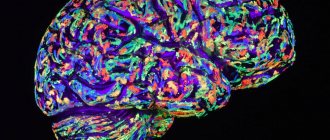What is self-awareness
Self-awareness
- this is a person’s understanding of the essence of his own personality, awareness of his place in society and the whole picture of the world. This is the vision and analysis of personal emotions, feelings and motives of behavior.
The peculiarity of self-awareness is that a person figuratively bifurcates:
- on the one hand, he is an object of knowledge for himself;
- on the other hand, consciousness acts as a subject for studying an object.
With the help of self-awareness, we see our emotions, feelings and needs, understand the motivation for our actions and what role we play in society. We recognize ourselves as a separate unit, a personality, but at the same time, embedded in the surrounding objective world.
A person can say about himself: “I am Evgeny Ivanov, I am 47 years old, I am a mechanic. I have parents, a wife and two children. My needs for a roof over my head and food are satisfied. I have friends with whom I spend time fishing and satisfy my need for communication. But I also want to have a car and play tennis, and now I’m working to achieve these goals.”
Of course, the description presented is very primitive, but it reflects the essence of the self-awareness of a person who understands his characteristic features and characteristics that distinguish him from other people.
The essence of self-awareness and its structure in different concepts
Definition 1
Self-awareness is a special form of a person’s awareness of himself and his essence, which manifests itself in the form of self-perception, self-esteem, and self-control.
Thanks to self-awareness, a person stands out among all living beings, because only a person can direct mental activity to his inner world, form an image of “I”.
The development of self-awareness occurs from elementary forms, such as self-awareness, self-perception, to more complex ones - self-esteem, self-reflection, self-knowledge.
Self-awareness, says A.G. Spirkin, includes awareness of partial characteristics, thanks to which a person gains the opportunity to holistically assess himself and his place in life.
Regarding self-awareness, the positions of I.I. are similar. Chesnokova and V.V. Stolin, who consider self-awareness to be an inextricable unity of such independent internal processes as self-knowledge, emotional and value-based attitude towards oneself and self-regulation of behavior in society. In other words, it is seeing oneself as if from an outsider’s perspective.
Finished works on a similar topic
- Course work Personal self-esteem in the structure of self-awareness 490 rub.
- Abstract Personal self-esteem in the structure of self-awareness 230 rub.
- Test work Self-esteem of personality in the structure of self-awareness 250 rub.
Receive completed work or specialist advice on your educational project Find out the cost
V.S. has a different point of view. Merlin, who relates self-awareness to the subject of activity, and not to the individual directly. He understands self-awareness as a person’s awareness of his own personality as a subject of activity.
V.S. Mukhina places greater emphasis on the relationship to individual links of self-awareness, believing that self-awareness represents value orientations that form a system of personal meanings and constitute the individual being of a person.
The structure of self-awareness includes three components:
- cognitive,
- evaluative,
- behavioral.
The cognitive component or self-knowledge is a person’s knowledge of himself, which develops into a certain image of the “I”, including the “real I”, “ideal I”, “fantastic I”.
The evaluative component or self-attitude is the attitude towards what a person knows about himself, how he evaluates his own qualities, as a result forming self-esteem. The formation of self-esteem occurs on the basis of comparisons of oneself with other people and opinions about oneself. Self-esteem associated with the level of a person’s aspirations can be overestimated, underestimated, adequate, inadequate.
Too lazy to read?
Ask a question to the experts and get an answer within 15 minutes!
Ask a Question
The behavioral component or self-actualization relies on self-esteem. Based on the level of self-esteem and its adequacy, a person can behave differently.
In self-awareness, there is a natural level - the separation of the subject from the environment, a social level - comparing oneself with others, the personal level is associated with reflection. In addition, self-awareness performs certain functions - the formation of oneself as a unique personality, i.e. acquisition of one’s own image of “I”, as well as self-defense of one’s image of “I” as a factor in the stability of the individual in life.
Personal self-awareness in psychology
The concept of self-awareness is so complex and multifaceted that in psychology there is still no single concept of its understanding. Synonyms for the word are: “I am a self,” “I am a concept,” “self-identity.”
The basics of the concept were formulated by S.L. Rubinstein, who pointed out the possibility of self-awareness to understand oneself, the personal environment and the existing structure of relationships with people.
According to S.V. Vygotsky, self-consciousness is formed in a person by the end of adolescence. He connects this process with the ability to reflect (think, ponder), which is formed by the age of seven.
According to the theory of V.S. Merlin's understanding of himself consists of the following components:
- Distinctive features from other subjects and objects.
- Understanding your own emotions, having self-esteem.
- Awareness of oneself as a subject of activity.
Psychologists have identified the following criteria for self-awareness:
- Isolation of the individual from the environment (material and social).
- Understanding the ability to control oneself – actions and thoughts.
- Trying on the visible qualities of other people.
- The ability to see your needs and the deep motives of your actions.
- Awareness of one’s own character traits and personality traits, both existing and desired.
In addition, within the framework of self-awareness in psychology, such a factor as attitude towards other people is highlighted; it can also be different.
The egocentric layer assumes that the individual forms an attitude towards others in accordance with their attitude towards themselves. That is, if they love me, then I love, if they respect me, then I will respect.
The group-centric stage of relationships is based on the principle: “If a person belongs to a certain group, then he is correct.” It is assumed that the person himself belongs to this same group.
A prosocial approach ensures understanding of the value of any person and acceptance of him with all his shortcomings.
At the highest, estoholic level, other people are considered as part of the spiritual world, humanity and patience are positioned in relation to any individual.
Self-awareness in the personality structure
The concept of self-awareness. The relationship between consciousness and self-awareness Neuropsychological mechanisms of the development of consciousness and self-awareness
Personal self-awareness
In social psychology, there are three areas in which the formation and formation of personality takes place: activity, communication, self-awareness. In the course of socialization, the connections of a person’s communication with people, groups, and society as a whole expand and deepen, and the formation of an image of his “I” occurs in a person. The image of “I”, or self-awareness (idea of oneself), does not arise in a person immediately, but develops gradually throughout his life under the influence of numerous social influences and includes four components (according to V.S. Merlin): consciousness of the difference between oneself and the rest of the world; · consciousness of “I” as the active principle of the subject of activity; · awareness of one’s mental properties, emotional self-esteem; · social and moral self-esteem, self-esteem, which is formed on the basis of accumulated experience of communication and activity. Criteria for self-awareness: · separating oneself from the environment, consciousness of oneself as a subject, autonomous from the environment (physical environment, social environment); · awareness of one’s activity - “I control myself”; · awareness of oneself “through another” (“What I see in others can be my quality”); · moral assessment of oneself, the presence of reflection - awareness of one’s internal experience. In the structure of self-awareness we can distinguish: · awareness of close and distant goals, motives of one’s “I” (“I am as an active subject”); · awareness of your real and desired qualities (“Real Self” and “Ideal Self”); · cognitive, cognitive ideas about oneself (“I am as an observable object”); emotional, sensual self-image. Thus, self-awareness includes: self-knowledge (the intellectual aspect of knowing oneself) and self-attitude (the emotional attitude towards oneself)
In general, three layers of human consciousness can be distinguished : · attitude towards oneself; · attitude towards other people; · expectation of other people's attitude towards oneself (attributive projection). The attitude towards other people, the awareness of this attitude can be qualitatively different: · the egocentric level of relations (the attitude towards oneself as an intrinsic value affects the attitude towards other people (“If they help me, then they are good people”)); · the group-centric level of relations (“If another person belongs to our group, he is good”); · prosocial level (“Another person is self-worth, respect and accept the other person for who he is”, “Do to others the way you would like them to do to you” ); · estocholic level - the level of outcomes (“Each person is in a certain relationship with the spiritual world and with God. Mercy, conscience, spirituality are the main thing in bearing towards another person”).
The concept of self-awareness. The relationship between consciousness and self-awareness Consciousness is the highest, human-specific form of generalized reflection of the objective stable properties and patterns of the surrounding world, the formation of a person’s internal model of the external world, as a result of which knowledge and transformation of the surrounding reality is achieved. The function of consciousness is to formulate the goals of activity, to preliminary mentally construct actions and anticipate their results, which ensures reasonable regulation of human behavior and activity. A person’s consciousness includes a certain attitude towards the environment and other people. The following properties of consciousness are distinguished: · building relationships; · cognition; · experience. This directly follows the inclusion of thinking and emotions in the processes of consciousness. Indeed, the main function of thinking is to identify objective relationships between phenomena of the external world, and the main function of emotion is the formation of a person’s subjective attitude towards objects, phenomena, and people. These forms and types of relationships are synthesized in the structures of consciousness, and they determine both the organization of behavior and the deep processes of self-esteem and self-awareness. Really existing in a single stream of consciousness, an image and a thought can, colored by emotions, become an experience. Consciousness develops in humans only through social contacts. In phylogenesis, human consciousness developed and becomes possible only under conditions of active influence on nature, in conditions of labor activity. Consciousness is possible only in the conditions of the existence of speech language, which arises simultaneously with consciousness in the process of labor.
And the primary act of consciousness is the act of identification with the symbols of culture, which organizes human consciousness, making a person human. The isolation of meaning, symbol and identification with it is followed by implementation, active human activity in reproducing patterns of human behavior, speech, thinking, consciousness, active human activity in reflecting the world around us and regulating one’s behavior. There are two layers of consciousness (V.P. Zinchenko). Existential consciousness (consciousness for being), including: · biodynamic properties of movements, experience of actions; · sensory images. Reflective consciousness (consciousness for consciousness), including: · meaning; · meaning. Meaning is the content of social consciousness assimilated by a person. These can be operational meanings, objective, verbal meanings, everyday and scientific meanings - concepts. Meaning is a subjective understanding and attitude to a situation and information. Misunderstandings are associated with difficulties in comprehending meanings. The processes of mutual transformation of meanings and senses (understanding of meanings and meaning of meanings) act as a means of dialogue and mutual understanding. At the existential layer of consciousness, very complex problems are solved, since for effective behavior in a given situation it is necessary to update the image and the necessary motor program needed at the moment, i.e. the image of action must fit into the image of the world. The world of ideas, concepts, everyday and scientific knowledge correlates with the meaning (of reflective consciousness). The world of industrial, objective-practical activity correlates with the biodynamic fabric of movement and action (the existential layer of consciousness). The world of ideas, imaginations, cultural symbols and signs correlates with the sensory fabric (of existential consciousness). Consciousness is born and is present in all these worlds. The epicenter of consciousness is the consciousness of one’s own “I”. Consciousness : · is born in being, · reflects being, · creates being. Functions of consciousness : · reflective, · generative (creative and creative), · regulatory-evaluative, · reflexive function - the main function that characterizes the essence of consciousness.
The objects of reflection can be:
· reflection of the world, · thinking about it, · ways a person regulates his behavior, · the processes of reflection themselves, · his personal consciousness. The existential layer contains the origins and beginnings of the reflective layer, since meanings and meanings are born in the existential layer. The meaning expressed in a word contains: · image, · operational and objective meaning, · meaningful and objective action. Words and language do not exist only as a language; they objectify the forms of thinking that we master through the use of language. Interaction of consciousness and subconsciousness In the zone of clear consciousness, a small part of signals simultaneously coming from the external and internal environment of the body is reflected. Signals that fall into the zone of clear consciousness are used by a person to consciously control his behavior. Other signals are also used by the body to regulate certain processes, but at a subconscious level. Awareness of circumstances that make it difficult to regulate or solve a problem helps to find a new mode of regulation or a new method of solution, but as soon as they are found, control is again transferred to the subconscious, and consciousness is freed to resolve newly arising difficulties. This continuous transfer of control, which provides a person with the opportunity to solve new problems, is based on the harmonious interaction of consciousness and subconscious. Consciousness is attracted to a given object only for a short period of time and ensures the development of hypotheses at critical moments of lack of information. Most of the processes occurring in a person’s inner world are not conscious to him, but in principle, each of them can become conscious. To do this, you need to express it in words - verbalize it. They distinguish: · subconscious - those ideas, desires, actions, aspirations that have now left consciousness, but can later come to consciousness; · the unconscious itself is a mental thing that under no circumstances becomes conscious. Freud believed that the unconscious is not so much those processes to which attention is not directed, but rather experiences suppressed by consciousness, those against which consciousness erects powerful barriers. A person can come into conflict with numerous social prohibitions; in the event of a conflict, internal tension increases and isolated foci of excitation arise in the cerebral cortex. In order to relieve excitement, you must first of all realize the conflict itself and its causes, but awareness is impossible without difficult experiences, and a person prevents awareness, these difficult experiences are forced out of the area of consciousness. To eliminate such a pathogenic influence, it is necessary to recognize the traumatic factor and reassess it, introduce it into the structure of other factors and assessments of the inner world and thereby defuse the focus of excitation and normalize the person’s mental state. Only such consciousness eliminates the traumatic impact of an “unacceptable” idea or desire. Freud's merit is that he formulated this dependence and included it in the basis of the therapeutic practice of psychoanalysis.
Psychoanalysis is a search for hidden foci in the cerebral cortex that arise when unacceptable desires are repressed, and carefully helping a person understand and reassess the experiences that trouble him. Psychoanalysis includes: · searching for a focus (remembering it); · opening it (translating information into verbal form); · re-evaluation (changing the system of attitudes, relationships) of the experience in accordance with the new significance; · elimination of the source of excitation; · normalization of a person’s mental state. Only by translating unconscious impulses into consciousness can one achieve control over them, acquiring greater power over one’s actions and increasing self-confidence. So, consciousness as an internal model, reflecting a person’s external environment and his own world in their stable properties and dynamic relationships, helps a person act effectively in real life. Mental states of a person Mental states are holistic characteristics of mental activity over a certain period of time. Taking turns, they accompany a person’s life in his relationships with people and society. In any mental state, three general dimensions can be distinguished: · motivational and incentive; · emotional-evaluative; · activation-energy (the first dimension is decisive). Along with the mental states of an individual person, there are also “mass-like” states, that is, mental states of certain communities of people (micro and macro groups, peoples, societies). In the sociological and socio-psychological literature, two types of such conditions are specifically considered - public opinion and public mood. Human mental states are characterized by integrity, mobility and relative stability, relationship with mental processes and personality traits, individual originality and typicality, extreme diversity, polarity. The integrity of mental states is manifested in the fact that they characterize all mental activity as a whole in a certain period of time and express the specific relationship of all components of the psyche. The mobility of mental states lies in their variability, in the presence of stages of progression (beginning, certain dynamics and end). Mental states are relatively stable, their dynamics are less pronounced than those of mental processes (cognitive, volitional, emotional). At the same time, mental processes, states and personality traits are closely interconnected. Mental states influence mental processes, being the background of their course. At the same time, they act as “building material” for the formation of personality traits, primarily characterological ones. For example, a state of concentration mobilizes the processes of attention, perception, memory, thinking, will and emotions of a person. In turn, this state, repeated many times, can become a personality quality—concentration. Mental states are characterized by extreme diversity and polarity. The latter concept means that each mental state of a person corresponds to an opposite state (confidence - uncertainty, activity - passivity, frustration - tolerance, etc.). Human mental states can be classified on the following basis:
· depending on the role of the individual and the situation in the occurrence of mental states - personal and situational; · depending on the dominant (leading) components (if they clearly appear) - intellectual, volitional, emotional, etc.; · depending on the degree of depth - states are (more or less) deep or superficial; · depending on the time of occurrence - short-term, protracted, long-term, etc.; · depending on the impact on the personality - positive and negative, sthenic, increasing vital activity, and asthenic; · depending on the degree of awareness - states are more or less conscious; · depending on the reasons causing them; · depending on the degree of adequacy of the objective situation that caused them. We can highlight typical positive (sthenic) ones - love, etc. and negative (asthenic) - grief, for example, mental states. For example, indecision as a mental state can arise not only when a person lacks independence and self-confidence, but also due to the novelty, ambiguity, and confusion of a particular life situation, in extreme conditions. Such conditions lead to a state of mental tension. In a state of mental tension, one should highlight a state of purely operational (operator, “business”) tension, i.e. tension that arises as a result of the complexity of the activity being performed (difficulties in sensory discrimination, states of vigilance, complexity of hand-eye coordination, intellectual load, etc. .) and emotional tension caused by emotional extreme conditions. Sleep states. The role of sleep Traditionally, psychology recognizes two states of consciousness inherent in all people: sleep, considered as a period of rest; · a state of wakefulness, or an active state of consciousness, which corresponds to the activation of the entire organism, allowing it to capture, analyze signals from the external world, send some of them to memory, or respond to them with adequate or inappropriate behavior depending on previous experience and skills. Thus, wakefulness is a state in which we can adapt to the external world. On average, our body functions with an alternation of 16 hours of wakefulness and 8 hours of sleep. This 24-hour clock is controlled by an internal control mechanism called the biological clock, which is responsible for activating the sleep center located in the brain stem and the wakefulness center in the reticular formation of the brain. For a long time it was believed that sleep is simply complete rest for the body, allowing it to restore the strength expended during wakefulness. Thus, lack of sleep significantly affects behavior: mental and work activity worsens or is even disrupted; some people literally fall asleep while standing, hallucinate or begin to delirium after 2-3 days of sleep deprivation. It is now known that sleep is not just a recovery period for the body, but includes various stages and performs various functions. There are “slow-wave sleep” and “rapid, paradoxical sleep” depending on the characteristics of brain activity.
According to Hartman's hypothesis (1978) , disconnecting a person from the external environment during sleep is necessary for meaningful processing of information accumulated during the day. Dreams reflect the motivation and desires of a person; these motivations seem to emerge during sleep, when the cells of the reticular formation send exciting impulses to the centers responsible for drives and instincts. Dreams serve, as it were, for the symbolic realization of a person’s unfulfilled desires; they discharge pockets of excitement that have arisen due to unfinished business and disturbing thoughts. According to Freud, dreams provide psychological comfort by reducing the emotional tension that arises during the day, thereby causing a feeling of satisfaction and relief. Research by Fowlkes (1971) showed that dreams, intense brain work during sleep, are intended to help a person solve his problems during sleep or to weaken or even eliminate a desire or experience that worries a person. According to the hypothesis of French and Fromm , in dreams the mechanisms of figurative thinking are used to resolve motivational conflicts that cannot be resolved with the help of logical analysis during wakefulness, i.e. dreams represent a mechanism of psychological protection and stabilization of a person, thanks to which a person draws the energy necessary to resolve your problems. Dreams are a kind of “window” into a person’s unconscious and a kind of “channel” for the exchange of information between the unconscious and consciousness, when a more information-rich unconscious is able to convey important information to consciousness in a symbolic or explicit form (for example, prophetic dreams about future possible events, about emerging diseases , about internal mental pain points, etc.).
List of recommended literature 1. Ananyev B. G. Man as an object of knowledge. - L.: Leningrad State University Publishing House, 1968. 2. Asmolov A. G. Psychology. - M., 1990. 3. James W. Psychology. - M.: Pedagogy, 1991. 4. Zinchenko V. P. Myths of consciousness and the structure of consciousness // Issues. psychology. - 1991. - No. 2. - P. 15-36. 5. Leontyev A. N. Activity. Consciousness. Personality. - M.: Politizdat, 1975. 6. Rubinstein S. L. Fundamentals of general psychology. - M., 1948. 7. Spirkin A.G. Consciousness and self-awareness. - M.: Politizdat, 1972. 8. Chesnokova I. I. Problems of self-consciousness in psychology. - M., 1977. 9. Frankl V. Man in search of meaning. - M.: Progress, 1990.
Structure and functions of self-awareness
Regarding the structure of the concept in psychology, there is also no single approach; several alternatives are considered.
Thus, in the works of V.S. Mukhina’s self-awareness includes: identification of a person with his own property and physical body, gender, self-esteem and claims to evaluation by society.
V.S. Merlin sees the structure of the concept somewhat differently and includes in it:
- Understanding personal mental characteristics.
- Awareness of the “I” as an active subject.
- Recognition of personal identity.
- Assessing one’s own mental qualities from the point of view of moral and ethical rules.
V.V. Stolin defines the following parts of self-understanding: self-esteem, the created image of oneself (body, emotions, feelings), the conflicting essence of one’s “I”.
Summarizing the existing concepts, the structure of self-knowledge can be represented as follows:
- the cognitive part
is a person’s awareness of all aspects of his own personality; - self-esteem
– a person’s attitude to his characteristics, both physical and spiritual, emotional;
- self-regulation
– a person’s ability, based on knowledge about himself, to control, regulate and correct his behavior and actions.
In addition to different periods of life, the structure of self-understanding also includes:
- "I" today
. This is an idea of one’s personality at the current moment in time, an awareness of one’s position in reality. We evaluate existing social roles: what kind of worker, husband, father, etc. am I. If the ideal image and the real one do not coincide, experiences may arise. - "I" is desired
. These are a person’s ideas about the ideal image to which he strives. This component includes: needs, dreams and desires. It is this “I” that is the main motivator for productive activity. - “ I” is previous, including an assessment of oneself in the past
. If a person has had unpleasant or painful experiences early in life, this may hinder the fulfillment of needs in the future.
All of the listed components of self-awareness are interconnected and influence each other.
Functions
The most important function of self-awareness is self-regulation
. Since we have fully identified ourselves, realized resources (positive and negative characteristics, potential, opportunities), understand needs and desires, he can act towards creating his ideal image.
When a person is mistaken about his own needs or inadequately assesses available opportunities, he will not receive satisfaction from his activities. Either he will rush in the wrong direction, or he will not have enough strength and potential to fulfill his desire. In both cases, disappointments and the occurrence of frustrations (strong experiences due to unfulfilled hopes and expectations) are inevitable.
Self-regulation will save a person from pointlessly wasting energy and time on unnecessary goals.
The next function is self-understanding
- This is the formation of individuality. Personality is always unique, each of us is unique. Only we ourselves know what feelings we experience, how we react to difficulties and obstacles, our pain is only our pain.
We have the right to our own perception of life, personal opinion and want to be responsible for our actions. Individuality and uniqueness must be defended throughout life.
Among the main functions are the definition of personal boundaries, self-defense
. We learn to structure our behavior in such a way that we experience less toxic influence from others. Extraordinary individuals are often ostracized (persecuted) in society. Unusual abilities and appearance, one’s own view of things, different from the generally accepted one, often make a person a “black sheep” that his brothers try to peck. A conscious sense of peace and self-confidence allows you to build a strong line of defense.
For example, if a person loves his body, he will not pursue imposed standards of beauty, if he considers it immoral to do mean things, he will not make a career by “setting up” his colleagues, even if this is accepted in the team, etc.
There is such a technique in psychology. If you are confident that you are right and live according to the principles you have developed, then in the event of attacks, imagine yourself as a rubber ball that no one can pinch. It is better to lose a toxic environment than to lose yourself.
Abstract on the topic: The emergence and development of human self-awareness.
Abstract on the topic:
The emergence and development of human self-awareness.
Content
Introduction
- The emergence and development of human self-awareness.
- Managerial identity
Conclusion
Bibliography
Introduction
The need to emphasize the existential status of consciousness is due to the fact that in philosophical and psychological literature consciousness is often identified with self-awareness. Self-awareness is understood as an attitude to reality, i.e. comes down to an epistemological, cognitive attitude. In other words, the everyday “evidence” of consciousness became possible due to its identification with self-consciousness. Self-awareness is such an obvious phenomenon for each of us that the fact of its existence does not raise any doubts.
Consciousness has the status of being: it exists in the practice of real life and for the purposes of this life. Consciousness is a conscious being; it is found in the system of social connections and relationships into which a person is drawn and in which he acts.
The main psychological task is to analyze the process of development of individual consciousness, the process of formation of reflexive consciousness. As the subject of psychological analysis proper, consciousness appears in the form of the practice of consciousness. The practice of consciousness is the process of mastering consciousness, overcoming complete absorption in the current process of life, taking a position above it. The practice of consciousness transforms existential consciousness into reflection or reflexive consciousness.
The necessary and first stage in the formation of reflexive consciousness is self-awareness, or consciousness of the self. In other words, reflection as a practice of consciousness reveals itself as a varying degree and depth of awareness of the self, one’s own subjectivity. Self-awareness as awareness of oneself, as consciousness of one’s self, depending on the goals and objectives facing a person, can take various forms and manifest itself as self-knowledge, as self-esteem, as self-control, as self-acceptance.
A person’s focus on knowing his physical (bodily), mental, spiritual capabilities and qualities, his place among other people is the essence of self-knowledge. Self-knowledge is accomplished, firstly, in the analysis of the results of one’s own activities, one’s behavior, communication and relationships with others by comparing these results with already existing standards. Secondly, when realizing the attitude of others towards me (evaluations of the results of my activities, actions, character traits, level of development of abilities, qualities of my personality). Thirdly, self-knowledge is accomplished in self-observation of one’s states, experiences, thoughts, in the analysis of the motives of actions, etc. Self-observation can occur both during an activity or communication with others, and after that, when recalling the past.
Self-knowledge is the basis for the development of constant self-control and self-regulation of a person. Self-control is manifested in the subject’s awareness and assessment of his own actions, mental states, in the regulation of their course based on the requirements and norms of activity, behavior, and communication. Self-control is a special psychological mechanism of a person as a subject of activity, cognition and communication.
Self-knowledge also acts as the basis for the implementation of an evaluative attitude towards oneself, or self-esteem. The difference between self-knowledge and self-esteem can be presented as a discrepancy between the cognitive-cognitive and evaluative-value components of self-awareness. Self-knowledge may include self-esteem, but it can also be purely ascertaining, non-evaluative. Self-esteem is that component of self-awareness that includes knowledge about one’s own self, a person’s assessment of himself, and a scale of significant values in relation to which this assessment is determined.
1. The emergence and development of human self-awareness
For a deeper understanding of the nature and functions of self-awareness, those of its elements that are most significant in management activities, it seems appropriate to turn to the analysis of various points of view on the emergence and development of human self-awareness.
V.N. Myasishchev considered the main criterion for the emergence of self-awareness to be the child’s ability to express an emotional attitude towards himself.
Some researchers, including I.S. Kon, consider adolescence and youth to be the period of emergence and formation of self-awareness, noting that individual components of its structure are formed in earlier age periods, but only in adolescence they are synthesized and acquire the character of a new formation.
Of considerable interest is the point of view expressed by V.V. Stalin. He believes that there are several prerequisites, several sources for the emergence of self-awareness, and each of them marks the same process (the development of self-awareness), but at a higher level. The author considers the first source to be the beginning of motor activity, when the child has a vague idea of his own existence, the second is the mastery of speech, and the third is the development of involuntary actions into voluntary ones.
V.V. Stalin also expresses the opinion that it is possible to consider the process of development of self-consciousness from the point of view of the constituent elements of its structure, that is, to more fully analyze the circumstances under which certain phenomena of self-consciousness arise. In his works, he examines the emergence and development of such phenomena of self-consciousness as self-selection, assimilation and differentiation, active and reflexive “I”, etc.
Addressing the problem of life strategy, KA. Abulkhanova-Slavskaya emphasizes the importance for every person to learn to live according to their capabilities, abilities, character, which requires knowledge and understanding of oneself. “The art of life consists not only in taking into account one’s individuality, but also in correlating one’s life goals, plans and desires with one’s characteristics in order to reveal new qualities in oneself in the course of life and develop new abilities.” Psychologists associate self-expression with the manifestation of individuality. It is noted that an adequate assessment of oneself (self-esteem) is important both for an individual to determine his place in life, to choose a life position, and for the active implementation of this position. Attitude towards oneself, in addition to self-esteem, should include a constant need for self-knowledge.
CA. Abulkhanova-Slavskaya emphasizes the importance of the ability to internal dialogue in the formation of the image of “I”. The dialogical nature of human consciousness was defined by M.M. Bakhtin. “An undeveloped image of oneself, an inability to reflect, to make adequate assessments ... of one’s personality as a whole, leads a person to a state of “internal dead end” when he knows himself worse than those people with whom he directly communicates. The lack of self-knowledge and self-esteem leads to the fact that a person submits to the power of his first impulses, untested opinions or, on the contrary, fixed (once and for all) attitudes.”
In the study of K.A Abulkhanova-Slavskaya, various personality types are identified according to the nature of the connection between self- and mutual assessment. The author, based on experiments, argues that the simultaneous counter-evaluation of each other by people allows everyone to more adequately expect evaluations from others and evaluate themselves. The ability to see oneself both “from the inside and the outside” and the harmonious coordination of these visions serves as the basis for adequate self-awareness.
The results of her research into evaluative-self-evaluative relationships of the individual are presented in the form of eight types.
Egocentric type. Self-esteem, regardless of the assessment of oneself by others and one’s own assessment of others, is constant, high..
Collegiate type. Self-esteem, given through comparing oneself with others, relying on the assessments of others and oneself by others, is constantly positive.
The directive type has a positive reputation, the egoistic type has a negative reputation. Self-esteem through one’s “reputation”, that is, through the assessment of oneself by others, the predominance of negative assessments of others.
Functional type. Self-esteem through comparison with others, but by focusing on norms rather than their attitudes. Self-esteem is average, inconsistent; the need to evaluate others and receive their assessments is weakly expressed.
Initiative type. Self-esteem manifested itself as confidence in the good attitude of others and, at the same time, as the need to evaluate them critically.
Reflexive type. Reflexivity and self-criticism are independent of one’s assessment of others and others’ assessment of oneself. Self-esteem is fickle.
Reflexive (second) type. Self-esteem is vague, unexpressed, out of connection with others: there is a need to be assessed by others, but there is no need to evaluate them.
Conflicting low self-esteem. There is a need to evaluate others, but there is no need to evaluate them.
Thus, self-esteem, according to KA Abulkhanova-Slavskaya, can be formed by contrasting one’s own opinion about oneself with the opinions of others, or it can take the opinions of others as a basis, but refuse their real assessments.
In foreign studies, two directions of research into the problem of self-awareness are quite clearly visible: a concrete scientific, purely psychological direction, seeking to reveal the mechanisms of formation of self-awareness, its stages, exploring the problems of self-regulation, self-control and self-esteem; and philosophical and psychological, closely related to the study of the spiritual world of man, the search for the meaning of his existence.
Among the representatives of the first direction, the works of the American psychologist J. Mead are of significant interest. He proceeds from the fact that a person is always the object of other people’s attitudes. Self-awareness is the transformed and internally transferred point of view of others regarding a person as a subject. J. Mead considers significant relationships in this regard to be the child-parent relationship of brothers and sisters, as well as educators and teachers. Domestic psychology considers this position quite contradictory. In particular, G.M. Andreeva criticized her for separating consciousness from activity and social conditions.
An important role is played by the problem of self-awareness in the works of K. Levin. For him, the so-called “target approach”, the target structure of the individual, is of greatest interest. It has been found that goal choice controls many factors, including experience, value systems, social and cultural norms, and therefore has a significant impact on an individual's sense of self.
Another contribution of K. Lewin to research in the field of self-awareness was the identification of so-called “conflict meanings,” when a person’s self-awareness contains an internal conflict caused, for example, by the fact that a person is forced to perform an activity that is unpleasant to him.
E. Erikson came up with the idea of a level concept for the development of self-awareness; The various stages of development of self-awareness identified by this researcher are at the same time levels of its development, as if demonstrating the degree of its development. This approach is, to a large extent, close to domestic psychology, although in terms of content it gravitates toward the psychoanalytic direction.
The works of humanistic psychologists (A. Maslow, K. Rogers, R. Berne) are of significant interest.
The leading representative of humanistic psychology, A. Maslow, highlighted the individual’s need for self-actualization, a necessary condition for which is the individual’s awareness of the values of existence: truth, beauty, the goodness of the ancients, perfection, simplicity, comprehensiveness. The paths of self-actualization are the choice of growth opportunities and taking responsibility for one’s choice, a period of preparation for the realization of one’s capabilities, constant work; these are higher experiences, the revelation of one’s own “I”.
The famous psychologist and psychotherapist Yu Rogers considers the main task of personal development to be achieving a state of self-awareness in which a person fully understands and accepts himself. The scientist assigns an important role in solving this problem to psychotherapeutic assistance; Also worthy of significant attention is his idea that a whole series of changes, in fact, the development of self-awareness, can be achieved as a result of rather intensive communication between groups of people not connected by any specific goal.
No less significant is the thought of K. Rogers that a person is a person who is constantly creating himself, realizing his purpose in life, regulating the boundaries of his subjective freedom. A person is capable of transformation in his inner world, of giving assessments of his life that cannot be fully or adequately conveyed by describing only his state or his unconscious. This position draws attention to the fact that self-awareness is not some kind of frozen psychological structure. Believing self-awareness to be one of the main psychological elements of personality, K. Rogers also sees in it a continuous process of change and development.
Following A. Maslow and K. Rogers, the English psychologist R. Berne, who shares the humanistic view of man and defends “recognition of the natural and enduring value of each person, the importance of human relationships in the process of education,” believes that “the formation of a healthy self-awareness of an individual striving for knowledge, complete faith in one’s own strength” is the main problem of education.
“I am a concept,” as defined by R. Burns, “is the totality of all an individual’s ideas about himself, associated with their assessment,” which includes the descriptive component “I am an image” and the evaluative component (self-esteem or self-acceptance) and “a set of attitudes, self-directed”, containing three elements: a belief, an emotional attitude towards this belief and a corresponding reaction. In relation to the “I - concept”, these three elements of the attitude are specified as follows
“I” image is the individual’s idea of himself;
self-esteem is an affective assessment of this idea;
potential behavioral response, that is, those actions that can be caused by self-image and self-esteem.
The work of R. Burns is interesting because the author examines the issues of the formation of the “I-concept” in the process of schooling: the role of feedback, reactions, and expectations of others in the development of the “I-concept”; the relationship between a student’s self-esteem and his academic performance; pedagogical conditions for increasing children's self-esteem in the process of schooling, etc. The latter include psychological training, psychological counseling, mutual understanding and effective interaction between teacher and student.
A generalized psychological and philosophical approach to the problem of self-awareness is presented in the works of existentialist psychologists E. Fromm and W. Frankl. Their views are directed mainly to the search for the meaning of human existence as a key link, his awareness of his place in the world.
E. Fromm considers this meaning to be love as a means of unity with others, overcoming the feeling of separation from the world and other people. In his opinion, such unity contributes to the awareness of a person as he is, the disclosure of his essential powers, and self-realization.
V. Frankl analyzes the concept of “existential vacuum” - a person’s loss of life meaning, leading to a conflict of self-awareness as a subjective product of the individual and the activity of the individual as an objective condition of its existence.
As can be seen from the above, the positions taken by domestic and foreign researchers, which have certain differences, largely coincide. Such coincidences include a number of fundamental provisions concerning the development of self-awareness, its structure, and the meaning-forming function of self-awareness for the individual.
Managerial identity
How to achieve success and become a master in your profession? How to determine your strengths and weaknesses? How to improve professionally? The answers to these questions are related to professional and managerial self-awareness.
N.V. Kuzmina calls managerial self-awareness one of the important components of a leader.
IA. Zimnyaya emphasizes the unifying, cementing role of managerial self-awareness in the development of a leader. It points to the need for targeted, ongoing professional and pedagogical training of managers for management activities, primarily in terms of self-awareness as its subject, the formation of managerial self-awareness.
What should be the object of awareness of a specialist? According to IA. Zimnyaya, for a manager, this is his professional knowledge (skills) and qualities (properties) that a manager must realize in his cooperation with subordinates; his personal qualities as a subject of activity; his own perception of himself as an adult who understands his employees well.
Exploring the development and structure of managerial self-awareness, A.I. Shugenko proves that the formation of a manager’s managerial self-awareness develops in the process of discovering and recognizing qualities, personal formations and properties of his “I” and assessing their influence on the development and personal growth of subordinates.
L.F. Voskresenskaya connects the formation of professional and managerial self-awareness of a leader with the formation of its main elements. From the perspective of the concept of person-centered education, it defines these basic phenomena of self-awareness:
experience of reflection and internal dialogue;
personal meaning of management activities;
self-esteem and level of professional aspirations;
awareness of one’s place in the structure of the management situation;
awareness of one’s social and managerial functions and capabilities;
experience in adequately resolving role conflicts in various management situations;
system of professional priorities;
system of professional ideals.
Based on the above opinions, it is possible to identify those qualities, the awareness of which will contribute to the formation of a manager’s managerial self-awareness. This is professional knowledge, abilities and skills, professionally significant qualities that a manager implements in working with subordinates; his personal qualities; his perception of himself as a specialist who is inclined to work with people; assessment by a manager of his influence on the spiritual, moral, general cultural, intellectual, and professional development of subordinates.
For success and self-improvement in professional activities, professional self-esteem, achievements and their significance for the individual are important.
L.I. Antsyferova emphasizes the importance of a specialist’s self-esteem as one of the most important components of his managerial self-awareness, the relationship between professional self-esteem and the success of professional activity. At the same time, she points to a well-known pattern in psychology: a person’s activity and his desire for self-improvement depend on self-esteem. Important criteria for managerial self-awareness and professional maturity of specialist L.I. Antsyferova believes:
the emergence of the phenomenon of “involvement” in activity, that is, its transformation into the main life value of the individual, a necessary condition for self-realization, a source of self-esteem and the formation of social status;
the ability to recognize trends in the development of the profession, reflect on leadership activities in a broad social context, independently determine and adjust the goals of their work;
the ability to search for and resolve contradictions in management activities, creative solutions to emerging problems, and rejection of unjustified stereotypes.
The relationship between managerial self-esteem, a positive self-image and the success of a specialist’s leadership activities requires a search for ways to develop these qualities in the process of professional training. In the analysis of ways to form a positive image of oneself as a problem of professional training, L.I. Antsyferova relies on the experience of foreign research. In particular, American researchers consider the most important principles for the formation of a positive self-attitude of a leader and a positive self-image to be the creation of conditions for a person to fully master professional culture and the rejection of all influences that reduce an individual’s self-esteem.
The achievements of an individual in educational and professional activities act as important prerequisites for positive changes in the individual himself, while the high significance of one’s own achievements can stimulate the development of a leader.
The maturity of managerial self-awareness is an indicator and a necessary condition for the formation of a manager’s professional skills, the development of his creative individuality, and the formation of a professional culture, while managerial self-awareness is defined as a system-forming component of professional excellence.
Managerial self-awareness as an individual’s awareness of himself in professional activity in all the diversity of his professional qualities, capabilities, abilities is one of the most important characteristics of a manager - a master, which allows us to talk about a new mental formation and a new level of development of his personality.
The structure of managerial self-awareness and personal self-awareness generally coincide and represent an intersecting and complementary combination of three substructures: cognitive, affective and behavioral (“I am understanding”, “I am attitude” and “I am behavior”). At the same time, the content of each substructure of managerial self-awareness includes specific characteristics determined by the characteristics of leadership activities that determine the self-development and self-actualization of a specialist in it.
The relationship between self-knowledge and self-esteem ensures self-regulation, promotes self-education and professional improvement of a leader.
There are three substructures in the structure of managerial self-awareness. Thus, the cognitive substructure (“I am understanding”) presupposes the leader’s awareness of himself in professional activities, interpersonal relationships associated with this activity, and his professionally significant personal qualities. The cognitive substructure of self-awareness is revealed in the process of self-observation, self-perception, based on the results of self-criticism, self-analysis, ending with self-esteem, which ensures the need for self-regulation and self-development. Thus, the cognitive substructure plays a leading role in managerial self-awareness.
The affective substructure (“I am an attitude”) is associated with the leader’s assessments and emotions about knowledge about himself and understanding himself. This is a person’s attitude towards himself (including self-respect or self-abasement, self-interest, etc.), which can manifest itself in pride or selfishness, modesty, pride.
The behavioral substructure (“I am behavior”) is determined by the manager’s satisfaction with himself and his professional activities, manifested in the desire to increase self-esteem, gain respect, etc., as well as in the conscious regulation of his actions, actions in relation to others and himself through restraint , self-control, self-control, self-regulation.
The main directions in the development of managerial self-awareness of a specialist are the formation of skills of self-observation, self-perception, self-analysis, self-esteem, self-control and self-regulation in professional activities.
At the level of introspection and self-perception, concepts about human qualities, including professionally important ones for a leader, begin to be transferred to oneself.
In the process of introspection and self-understanding, one’s behavior is correlated with the requirements of society, the characteristics of other people, the requirements for oneself, and self-esteem is formed. It is a subjective formation of the psyche. This is “an individual’s assessment of himself, his capabilities, qualities and place among other people. Referring to the core of personality, self-esteem is an important regulator of its behavior. A person’s relationships with others, his criticality, self-demandingness, and attitude toward successes and failures depend on self-esteem. Thus, self-esteem influences the effectiveness of a person’s activities and the further development of his personality.”
The level of a manager’s aspirations, expressed in the degree of difficulty of the goals and tasks that she sets for herself, is closely related to self-esteem. The discrepancy between the level of a manager's aspirations and his real capabilities has a negative impact on his professional and personal development. A high level of aspirations with limited capabilities leads to conflicts with subordinates, the team, with oneself, the occurrence of emotional breakdowns, increased levels of anxiety, etc. A low level of aspirations develops uncertainty in one’s capabilities, an inferiority complex, which inhibit the development of abilities, volitional sphere, and cause problems in communication and work with subordinates. Professional self-realization and self-improvement are possible only with adequate self-esteem and a level of aspirations corresponding to the real objective and subjective (mental) capabilities of the leader.
The formation of ideas about one’s personal and professional qualities, assessment of oneself in comparison with other specialists causes the manager to strive to increase self-esteem and win the respect of colleagues at work, which leads to the conscious regulation of one’s actions and deeds - self-regulation, which, in turn, contributes to self-development and self-actualization future leader-master.
Self-regulation is carried out by the “I” system, which is formed in the process of life and upbringing under the influence of the assessments of others and awareness of one’s capabilities.
No less important conditions for the development of managerial self-awareness of a leader are the increase in his psychological culture, including the culture of communication, the development of a democratic and humanistic position in relationships with subordinates and colleagues, as well as the formation of skills to overcome difficulties, one’s own egocentric position, and finally, awareness of the need for self-development, self-improvement. Self-improvement presupposes a certain level of self-awareness of the leader: the ability to introspect and self-assessment and the presence of a stable attitude towards self-improvement.
The internal incentives that encourage a manager to work on himself are established professional ideals and beliefs. The study of the psychological characteristics of a manager’s managerial activities should contribute to the formation of the need and readiness for professional self-improvement.
In psychological literature (A.B. Dobrovich, Yu.N. Emelyanov, L.A. Petrovskaya, etc.) as an opportunity to obtain an objective idea of oneself, develop skills of analysis and self-analysis and adequate self-esteem, ways of learning to communicate, ways of personal growth , socio-psychological training is considered.
Conclusion
Managerial self-awareness can be considered as an activity that has its own product - a “professional “I-concept”, and as an integral quality of a person, uniting and embodying all of her professional experience, as a system of value-semantic and cognitive-operational properties. From a functional point of view of managerial self-awareness can be considered as a process of constant constructive overcoming of difficulties that impede more complete professional self-realization of a manager;
The structure of managerial self-awareness includes a set of cognitive (“I am understanding”), affective (“I am attitude”) and behavioral (“I am behavior”) substructures, the content of which reflects the specifics of management activities. The constituent components of the structure of self-awareness can be presented as stages of its development (with the subsequent stage being formed on the basis of the previous one), and the process of formation of self-awareness can be presented as a step-by-step process (from “I - understanding” to “I - attitude” and from them - to “I - behavior"). Moreover, each stage passed is characterized by a certain level of its functioning.
The path to developing managerial self-awareness is the general and professional development of a manager. At the same time, the formation of self-awareness, “selfhood” is inextricably linked with the development of the spiritual world of the leader. This means that the formation of a manager’s managerial self-awareness should be carried out in unity with the formation of a system of his spiritual, professional and personal values.
A significant influence on the formation of managerial self-awareness as a whole is exerted by the development of its individual phenomena, as well as by the conditions of activity and communication in which the professional development of a manager takes place. The combination of self-esteem and orientation towards the assessment of others, relationships with other people, their character, the intensity of communication, acting mainly through the mechanisms of constructing the image of a “generalized other”, contribute to the formation of a realistic image of “I”.
Bibliography
- Baklanova N.K. Step towards success. Psychology for you .- M: Profizdat, 2000 .- P.11-28.
- Bandarka A.M. Psychology of management .- Kharkov: Fortuna-press, 1998 .- P.122-130.
- Myasnischev V.N. Consciousness as a unity of reflection of reality and a person’s attitude towards it // Problems of consciousness .- M: Logos, 1998 .- P.21-68.
- Pugacheva V.P. Personnel management of an organization. - M: Aspek-Press, 1999. - P.178-182.
- Slobodchikov V.I. Fundamentals of psychological anthropology. Human psychology .- M: School-Press, 1995 .- P. 191-199.
Forms and levels of human self-awareness
Self-awareness manifests itself in four forms, let's look at each of them.
Self-knowledge
This concept means identifying oneself among other people and the world around us, recognizing personal qualities, the physical body, and potential.
Self-awareness comes through:
- Self-observation of the results of one’s activities, the results of communication with the environment and analysis of the compliance of the results with accepted standards.
- Understanding the assessments of other people about their personality and actions, their attitudes.
- Analysis of your feelings, emotions and needs, and their transformations.
The result of self-knowledge is the formation of a system of ideas about oneself.
Self-control
A person has the opportunity, after analyzing his essence and behavior, to correct them. Any actions and psychological states can be changed if, in the opinion of the person himself, they contradict his attitudes, do not give the desired results, or come into conflict with the outside world.
Self-esteem
Self-esteem expresses the degree to which a person accepts his qualities, characteristics and characteristics. The perception itself reveals the level of love and respect for oneself.
Adequate self-esteem characterizes a self-confident person, capable of making decisions and purposeful actions. When low, we see a person dependent on the opinions of others, with a pronounced sense of guilt and a lot of complexes. An overestimation of personal qualities reveals a person who is self-confident, arrogant, and does not accept any criticism.
To achieve life goals, self-esteem should be developed to a normal level; in psychology there are many exercises to increase the degree of self-love.
Self-acceptance
This form of self-awareness involves:
- Accepting yourself as a unique individual, without unjustified criticism and self-deprecation.
- Self-respect.
Self-esteem comes from achieving goals and satisfying aspirations. A person sets records in sports, quits smoking, finishes writing a novel - his self-esteem increases, which has a good effect on self-esteem.
In addition to forms, psychology considers 4 levels of self-perception:
- Sensual
. This is the lowest level at which one’s psychological characteristics, experiences, and physiological processes are understood. This is the stage of self-identification. - Figurative and personal
. Gives recognition of oneself as a subject of active activity. Self-actualization occurs, maintaining the identity of “I”. - Analytical (otherwise reflexive)
. A person analyzes and clarifies his thoughts and actions, observes the manifestation of emotions in critical states, analyzes committed mistakes and failures, and draws conclusions. - Active
. Based on the results and experience of the first three stages, self-regulation, motivation, correction of behavioral structures and self-control occur. This is a stage of personal change based on self-knowledge.
Going through all four levels of self-awareness indicates the maturity of the individual; getting stuck on one of them requires further development.
How self-awareness is formed
The process of developing self-awareness is accurately described in the works of V.S. Mukhina in correlation with the development of the child’s psyche.
At the first stage, a person’s idea of his name is formed. First, he hears it from the lips of his parents and begins to identify himself accordingly. Thanks to the name, the child realizes himself as a person, an individual. Then the surname and patronymic are added, and the specification intensifies.
In the early school period, the name may change, other interpretations and nicknames of comrades appear. In youth, many come up with other names for themselves, associating their personality with them. During this period, there are cases of changing your passport data.
The next need for self-awareness is ideas about the body, formed first through the attitude of the close environment (parents, grandparents), and then using the traditions and cultural orientations existing in the family.
The need for recognition also occurs in early childhood. The baby learns what is good and bad, what is allowed and what is not allowed. Encouraging good deeds and good behavior leads to the desire to perform approved actions.
If demands for recognition are not satisfied by adults, the child develops negative qualities - lies, aggression, lack of self-confidence, and complexes appear.
During puberty, a teenager develops a gender identity. Of course, whether a child is a boy or a girl is determined by the age of three; a little later, stereotypes of male or female behavior appear.
In the process of self-understanding, a person develops an idea of social space, i.e. conditions in which growth and development occurs:
- style and lifestyle;
- cultural and ethical values;
- moral standards;
- attitude towards religion, etc.
In adolescence, a person strives to master the widest possible social space (from a group of comrades in the yard to the sphere of politics). During this same period, reflection on the inner world deepens in order to understand one’s needs and place in society.
The main signs of the development of self-awareness are: the presence of a holistic idea of oneself, self-respect, self-acceptance, awareness of love, discovery of the inner world.
Developing Self Awareness
Self-awareness appears in a child in early infancy, and by adolescence it is fully formed. However, this does not mean that you do not need to engage in self-perception throughout your life.
Changes occur in the objective world and subjective characteristics. These changes require observation and self-knowledge.
The first step is to analyze the current external and internal situations and re-recognize yourself and your attitude to changes. For example, with age, the body begins to age and our attitude towards it, formed in early periods, will also change. On the one hand, it is required to take greater care of physical health, on the other hand, to be able to accept age-related changes without unnecessary worries, with dignity.
It is also important to bring self-esteem to an adequate (normal) state. Throughout life, the level of love and self-respect may change due to external reasons or the attitude of loved ones. You cannot allow circumstances to sow doubts about your self-confidence.
And lastly, it is necessary to promptly adjust needs and actions according to life changes. It is impossible to stop at knowing about yourself; taking the same actions that do not lead to success is not constructive. Therefore, the process of self-awareness is permanent and ends only after the physical death of a person.
Self-awareness and personality development
Self-awareness is not an innate quality; it is acquired by constantly transforming throughout a person’s life. The most basic self-awareness that can be observed is the child's exploration of his body parts in order to understand how they can be controlled. However, self-awareness does not only occur at the level of bodily cognition. Over the years, a person can turn to his inner world, which is invisible to the eye.
As personality develops, self-awareness becomes as follows:
- Up to a year - when it is difficult for a child to separate himself from others. He actively begins to move his arms and legs, pronounces sounds, plays with toys, which gives him the first understanding that he is separated from the world.
- From 1 to 3 years - when a person begins to actively learn to control his movements in space and time. Here he first realizes his separate “I”, sometimes in a negative form trying to defend his independence.
- From 3 to 7 years - when the child realizes his separation from the world and stops talking about himself in the third person. He increasingly wants to become independent, resisting the various manipulations of others that were previously acceptable.
- From 7 to 12 years - when there are no crises and leaps in development. It’s just that the child gradually consolidates his self-awareness and isolation.
- From 12 to 14 years old - when the child again actively begins to wonder who he is in order to begin to look for his path in this life. An active “detachment” from parental care begins, which is often accompanied by scandals and quarrels.
- From 14 to 18 years old - when a teenager makes multiple discoveries for himself. He finally becomes an independent person who begins to interact with the world around him, influence it and shape his future.
Self-awareness requires turning your attention to yourself. To know yourself, you need to look at your nature with open eyes, without embellishing or evaluating anything. Self-awareness does not require identifying shortcomings in oneself in order to urgently correct them, and also does not encourage a person to understand in what ways he is not yet ideal, according to society. Self-awareness is aimed at recognizing oneself as a separate personality, which is in no way connected with the outside world.
go to top











